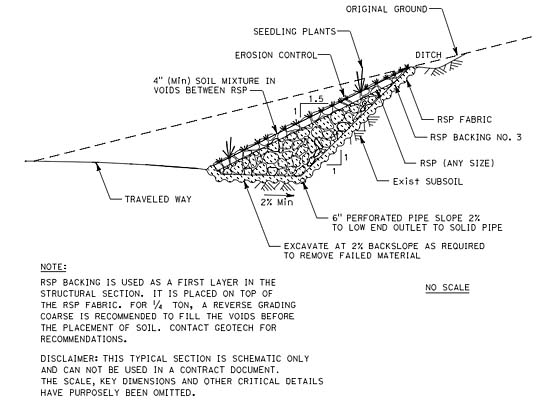Erosion Control Toolbox: Soil Filled Rock Slope Protection
Introduction

This work consists of placing 1/4 ton Rock Slope Protection (RSP) on slopes, placing plants between the rocks, and backfilling with topsoil. The soil backfill provides for the establishment of shallow rooted plants including annuals, perennials, willow cuttings, grasses or plants for erosion control.
Note that placing RSP for slope protection is different than RSP for riverbank or shoreline protection. For information regarding using RSP to protect river and shorelines, please see Chapter 870 of the Highway Design Manual.

Soil Filled RSP Training Video
Click here to watch a short video about Soil Filled RSP.
When to Use This Treatment
- Typically used to repair failed cut slopes
- Use to provide vegetative habitat, cover, or visual mitigation of cut slopes
- Use on slopes between 2:1 and 1.5:1 (H:V)
- Coordinate the use of this treatment with the Division of Engineering Services (DES) Office of Geotechnical Services, which may prepare a Geotechnical Design Report for slopes greater than 2:1 (H:V)
Benefits
- Maintains slope stability and prevents surface erosion, even where slopes feature subsurface water flows
- Rock Slope Protection meets storm water permit requirements for "cover" but vegetation softens the visual impact of rock slopes, provides habitat and long-term control of erosion
- Plant roots provide additional reinforcement of the slope
Limitations
- Costly
- May require additional time for coordination between landscape architects and geotechnical engineers
- Requires space for heavy equipment access
- Planting of willows or other deep rooted plants requires installation of biodegradable plant tubes at the same time as the rock placement
- Planting may be limited to the rainy season or require supplemental irrigation for establishment
Consider Using With
Specifications
- Refer to Standard Specifications - Section 72 Slope Protection
Updated: December 17, 2018

